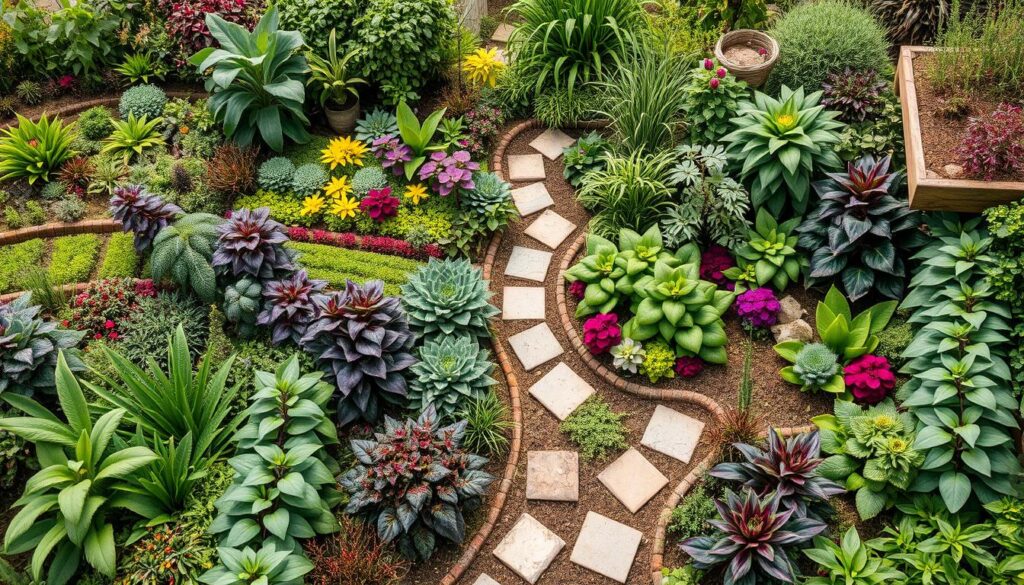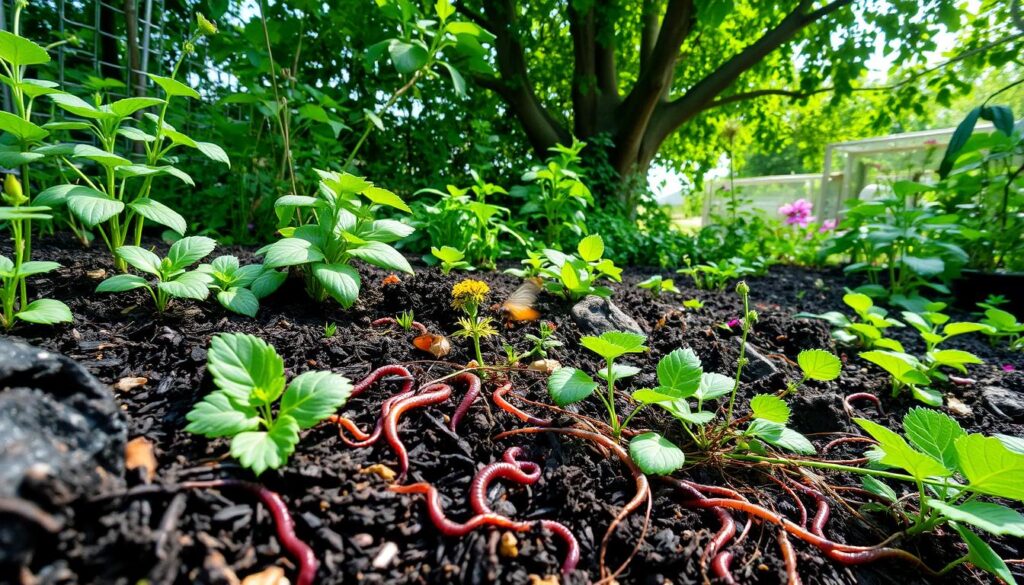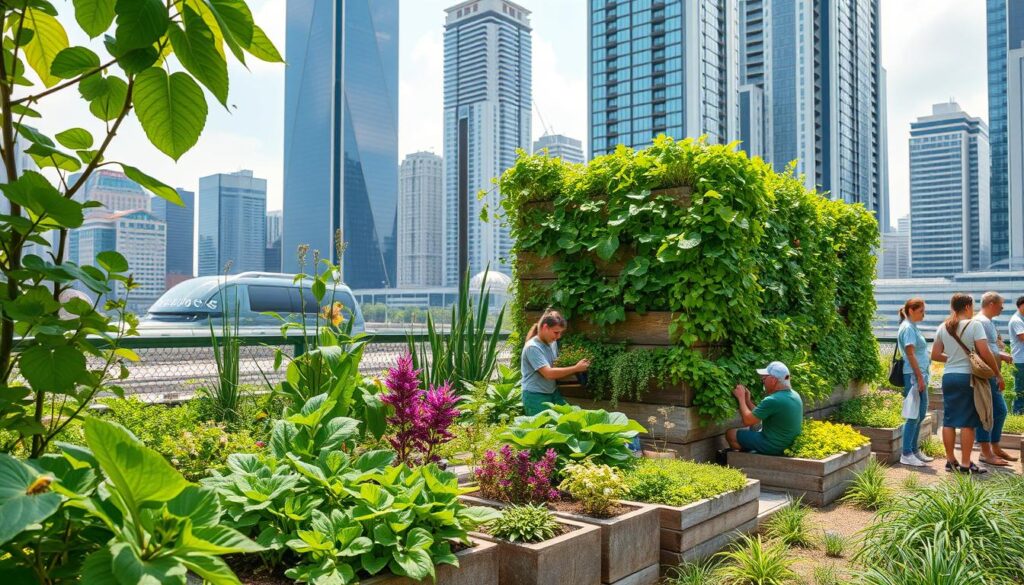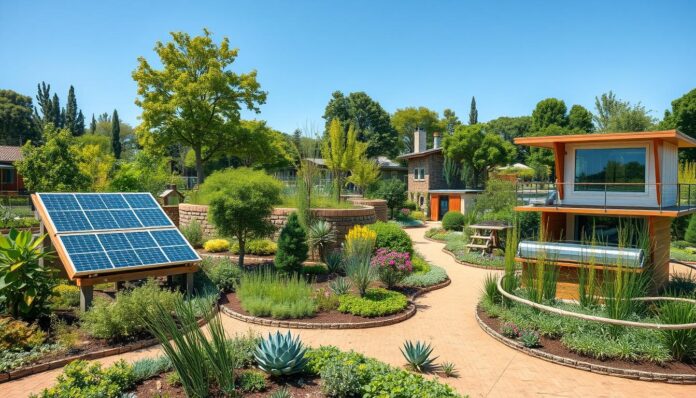Are you ready to change agriculture with new tech and green design? What if farming’s future could be smarter, better, and kinder to our planet?
Permaculture smart systems are changing farming for the better. They mix high-tech with nature’s wisdom. This new way of farming is key to growing food better and using resources wisely.
The market for farm tech is growing fast, expected to hit $31 billion by 2030. In the U.S., over 100,000 people have learned about permaculture. This shows more folks want to use smart farming methods.
These smart systems use sensors, data, and green energy to make farms better. They help farms use resources well, cut down on harm to the environment, and grow more food. This is done by watching over the farm closely and adjusting as needed.
Key Takeaways
- Smart systems are transforming sustainable agriculture
- Technology enables more efficient resource management
- Precision agriculture reduces environmental footprint
- IoT solutions enhance crop monitoring and productivity
- Permaculture principles can be scaled from gardens to entire communities
Understanding Permaculture and Smart Systems
Regenerative agriculture is a new way of farming that changes how we grow food. Permaculture is a key part of this change. It helps us see farming and nature in a new light.
Definition of Permaculture
Permaculture is a way to design farms that work like nature. It was started in the 1970s by Australians. It blends human farming with nature to make food systems that are strong and healthy.
- Focuses on sustainable land management
- Emphasizes ecological balance
- Promotes biodiversity and ecosystem health
The Role of Smart Systems in Permaculture
Smart farming tech is changing permaculture. It lets us watch over the environment closely. IoT sensors check things like soil moisture and nutrient levels. This helps us use resources better.
| Smart Agriculture Technology | Permaculture Benefit |
|---|---|
| Solar-powered Sensors | Minimal ecosystem disruption |
| IoT Data Collection | Improved resource efficiency |
| Non-invasive Monitoring | Wildlife preservation |
Benefits of Integrating Smart Systems
Agroecology gets better with tech. Smart systems can make farming 30% more water and fertilizer efficient. They also boost crop quality and amount by 20%.
The future of agriculture lies in harmonizing cutting-edge technology with ecological wisdom.
By using tech and permaculture together, farmers can make farms better. They become more sustainable, productive, and good for the environment.
Key Principles of Permaculture
Permaculture is a way to farm that looks at the whole picture. It changes how we see our relationship with nature. By following key ecological rules, farmers and gardeners can make landscapes that are strong and work well with nature.

The heart of permaculture blends biodynamic farming with new ways to farm. These rules help people make systems that are good for the planet.
Observe and Interact
This rule is about really getting to know nature. People learn to watch and understand the land before they start designing. Agroforestry strategies come from watching how nature works.
- Study local climate patterns
- Analyze soil composition
- Understand microclimate variations
- Identify natural water flows
Catch and Store Energy
Managing resources well is key in permaculture. This rule is about using natural energy sources. It’s about smart design and building things that help.
| Energy Capture Method | Potential Benefits |
|---|---|
| Rainwater Harvesting | Reduce water consumption, support irrigation |
| Solar Panel Installation | Generate renewable electricity |
| Thermal Mass Design | Regulate temperature naturally |
Produce No Waste
This rule changes how we see waste. It says that everything has value. In permaculture, every part of the system does more than one thing.
“Waste is simply a resource in the wrong place.” – Bill Mollison
- Compost organic materials
- Recycle nutrients within systems
- Design closed-loop processes
- Minimize external inputs
Types of Smart Systems for Permaculture
Permaculture automation is changing farming by adding new tech to sustainable farming. Smart agriculture is making farming more efficient and responsive. It’s a big change for how we farm.
Precision agriculture is key for modern permaculture. It solves old farming problems with new solutions. These smart systems help farmers use resources better and make their farms more productive.
Automated Irrigation Systems
Smart irrigation is a big step forward in water use for permaculture. These systems use sensors and IoT to:
- Check soil moisture in real-time
- Send water just when plants need it
- Save up to 50% of water
- Water different plants the right way
“Technology enables us to work smarter, not harder in agricultural systems” – Sustainable Agriculture Expert
Renewable Energy Solutions
New energy tech is changing permaculture. Solar and wind power make farms run on their own. This cuts down on the need for outside energy.
Smart Soil Monitoring
Soil monitoring has gotten a lot better. Precision agriculture sensors can:
- Check nutrient levels
- Watch microbial activity
- Spot disease risks
- Give advice on what to do next
These smart systems are the future of farming. They mix tech with nature in a new way.
The Importance of Soil Health
Soil is key to sustainable farming and regenerative agriculture. It’s a complex ecosystem that’s vital for permaculture success. Healthy soil supports plants, stores carbon, and makes farming systems strong.

Research has shown us how to improve soil health in biodynamic farming. The soil beneath us is full of life, with more biodiversity than any other place on Earth.
Understanding Soil Composition
Soil is more than just dirt. It’s a living mix of microorganisms, minerals, and organic matter. It includes:
- Minerals (sand, silt, clay)
- Organic matter
- Microorganisms
- Water and air spaces
“Soil is the great connector of lives, the source and destination of all.” – Wendell Berry
Techniques for Enhancing Soil Health
There are many ways to make soil better for farming. Some effective methods are:
- Composting
- Cover cropping
- Minimal tillage
- Mulching
| Practice | Soil Benefit | Impact Level |
|---|---|---|
| Composting | Nutrient Enrichment | High |
| Cover Cropping | Erosion Prevention | Medium |
| Minimal Tillage | Microorganism Preservation | High |
Using these strategies, farmers can build strong, self-sustaining ecosystems. These ecosystems support farming for a long time.
Water Management Strategies
Water conservation is key in sustainable farming. Permaculture automation brings new ways to tackle water issues in farming. Precision agriculture techniques change how we manage water, making farms more resilient and efficient.
Water scarcity is a big problem worldwide. Here are some important facts:
- Only 0.5% of Earth’s water is available for human use
- The average American uses 88 gallons of water daily
- Urban environments generate 55% water runoff
Rainwater Harvesting
Rainwater harvesting is a strong strategy for managing water. It lets farmers use rainwater instead of traditional sources. Strategic collection systems can turn rainfall into a valuable resource for farming.
Greywater Recycling
Greywater recycling is another important method in permaculture automation. Every person makes about 25-45 gallons of greywater daily. This is a big chance to save water.
| Water Management Strategy | Water Savings Potential |
|---|---|
| Rainwater Harvesting | Up to 40% reduction in water consumption |
| Greywater Recycling | Over 1000 gallons saved monthly per household |
Drip Irrigation Systems
Drip irrigation is a top choice in precision agriculture. It sends water straight to plant roots, cutting down on waste. Smart sensors help make sure plants get just the right amount of water.
Water is the driving force of all nature. – Leonardo da Vinci
Designing for Biodiversity
Permaculture smart systems are key to building strong and healthy ecosystems. Biodiversity is at the heart of sustainable farming. It offers a fresh way to farm that’s different from old methods.

The web of life in permaculture shows the strength of nature’s connections. Diverse ecosystems are more stable and productive. They also help protect against environmental problems.
Companion Planting Techniques
Companion planting is a smart way to boost biodiversity. It’s about pairing plants to help each other grow and stay safe. The main benefits are:
- Natural pest control
- Better soil health
- Higher crop yields
- Less need for chemicals
“In nature, diversity creates resilience.” – Permaculture Design Principle
Creating Habitats for Wildlife
Turning farms into wildlife homes is a big step in permaculture. Smart systems help keep track of these ecosystems. They use advanced tools to monitor and support them.
- Attract helpful insects
- Give shelter to local animals
- Help pollinators
- Make natural pest control
Research shows permaculture can boost local plant and animal life by up to 60% in five years. This amazing change shows the power of combining ecological design.
By focusing on biodiversity, permaculture experts build strong, self-sustaining systems. These systems work well with nature. They help keep the environment healthy and support farming.
Smart Technology Tools in Permaculture
The world of permaculture is changing fast with new technology. Precision agriculture and permaculture automation are changing how we manage our gardens. Smart tools are making sustainable gardening easier and more efficient.
Mobile Applications for Garden Management
Mobile apps are now key in precision agriculture. They offer new ways for gardeners to manage their spaces. These apps have features that make gardening easier:
- Crop tracking and planning systems
- Real-time plant health monitoring
- Personalized growing recommendations
- Harvest logging and yield prediction
Smart agriculture technologies are changing how we interact with our growing spaces, making sustainable practices more intuitive and data-driven.
Sensors for Environmental Monitoring
Environmental sensors are vital in smart agriculture. They give exact data on growing conditions. These tools help gardeners make better choices by tracking important environmental factors.
| Sensor Type | Monitored Parameter | Precision Level |
|---|---|---|
| Soil Moisture Sensors | Water Content | 99.5% Accuracy |
| Temperature Sensors | Ambient Temperature | ±0.5°C Range |
| Humidity Monitors | Atmospheric Moisture | ±3% Range |
By using these smart tools, gardeners can make their growing spaces better. The future of agriculture is in using these smart systems to use resources better and grow more.
Case Studies of Successful Integrations
Sustainable farming and urban agriculture are key to solving today’s food problems. These case studies show how permaculture can change food production in various settings.

Urban Permaculture Innovations
Urban agriculture has changed how we grow food in small spaces. The Bangalore Model Farm uses vertical farming to use resources well. It has achieved:
- Efficient space management
- Significant yield improvements
- Enhanced community engagement
“Urban permaculture transforms city landscapes into productive ecosystems” – Sustainable Agriculture Research Institute
Rural Permaculture Implementations
Rural farms have adopted smart systems to increase productivity and sustainability. These examples show the power of permaculture:
- Advanced water conservation methods
- Ecosystem diversity enhancement
- Multiple income stream development
These projects offer valuable lessons for future farming. By 2050, cities will be home to two-thirds of the world’s people. These new methods are more important than ever.
Permaculture design is a complete way to make farming sustainable. It connects urban and rural food production challenges.
Community Engagement and Education
Sustainable agriculture grows stronger with community ties. Permaculture smart systems turn local learning spots into places where people work together. They help people come up with new ways to farm.
Getting people involved is key to sharing agroecology ideas. Projects that use permaculture show how together, we can change farming for the better.
Workshops and Training Sessions
Teaching the community well needs smart plans. Permaculture courses offer deep learning, often in 72-hour sessions. They mix theory with hands-on skills.
- Interactive hands-on learning experiences
- Technology-enhanced training modules
- Collaborative skill-building workshops
Collaborative Permaculture Designs
Smart designs in farming come from community efforts. Online platforms help share knowledge far and wide. This makes permaculture education reach more people.
| Community Engagement Metric | Percentage |
|---|---|
| Online Platform Participation | 75% |
| Technology Adoption Rate | 60% |
| Sustainable Practice Implementation | 40% |
“Community is the greatest teacher in sustainable agriculture.”
Permaculture helps build strong, flexible farming systems. It empowers local groups to find sustainable farming solutions.
Challenges in Implementing Smart Systems
Permaculture automation offers great chances for sustainable farming. But, there are big hurdles in using smart agriculture technologies. Knowing these challenges helps farmers choose the right technology.
Smart agricultural technologies need careful thought. They involve looking at many factors that can affect success. The path to advanced permaculture systems is filled with financial and technological challenges.
Cost Considerations in Smart Agriculture
Starting with smart agriculture can cost a lot. Farmers must weigh the long-term gains against the initial costs. Key financial hurdles include:
- High equipment costs
- Installation and infrastructure changes
- Expenses for ongoing maintenance and upgrades
- Costs for training staff on new tech
Technology Adoption Barriers
Starting with permaculture automation comes with tech challenges:
| Challenge | Impact | Potential Solution |
|---|---|---|
| Learning Curve | Need for complex tech understanding | Comprehensive training programs |
| Resistance to Change | Old farming ways | Demonstration projects and peer networking |
| Technology Reliability | System failures | Redundant backup systems |
“The future of sustainable farming lies in strategically integrating smart technologies while respecting natural ecosystem principles.” – Agricultural Innovation Research Institute
Farmers can tackle these challenges by starting small, sharing resources, and learning continuously. Smart strategies turn obstacles into chances for innovation in sustainable farming.
Future Trends in Permaculture Smart Systems
Agriculture is changing fast with new tech. Smart and precision agriculture are leading the way. They’re changing how we grow food and care for our ecosystems.
New trends in permaculture automation are changing farming. These technologies offer big chances for sustainable food systems. The global ag tech market is growing fast, with big steps in several areas:
- Advanced Internet of Things (IoT) sensor networks
- Artificial intelligence-driven crop management
- Sustainable data analytics platforms
- Integrated ecosystem monitoring systems
Advancements in IoT and Agriculture
IoT is making precision agriculture better. It lets farmers monitor their land and make smart choices. They get tools that show them soil health, crop status, and how to use resources better.
“Technology is the bridge between human innovation and ecological sustainability.” – Agricultural Innovation Experts
Sustainable Practices and Innovations
Permaculture automation is getting better. It’s making farms more strong and able to adapt. New tech is helping farms grow more and take care of the environment better.
- Bioengineered crop varieties
- Advanced composting techniques
- Intelligent water conservation methods
- Autonomous farming equipment
These new trends show how smart systems can change farming. They make farming more green, efficient, and good for the planet.
Measuring Success in Permaculture Projects
Measuring the success of sustainable farming projects is more than just numbers. Precision agriculture and permaculture smart systems have changed how we look at success. They give us detailed views of how well ecosystems are doing and how productive they are.
Metrics for Evaluating Performance
Good permaculture projects use many ways to check how well they’re doing. Important things to look at include:
- Crop yield and quality
- Resource efficiency
- Biodiversity indicators
- Ecosystem resilience
- Carbon sequestration potential
“The true measure of a permaculture project is not just what it produces, but how it enhances the entire ecosystem.” – Permaculture Design Expert
Feedback Loops for Continuous Improvement
Having good feedback systems is key in permaculture smart systems. These systems help farmers:
- Collect real-time environmental data
- Analyze system performance
- Make informed adjustments
- Track long-term ecosystem development
SMART goal setting is important for project evaluation. Farmers should set goals that are Specific, Measurable, Articulate, Relevant, and Time-bound. This ensures a thorough check of the project.
Using advanced technologies helps track sustainable farming results more accurately. Tools like sensors, satellite imaging, and data analytics offer deep insights into ecosystem changes. This helps permaculture experts make their designs better over time.
Resources for Further Learning
Learning about sustainable agriculture is a journey. Agroecology and permaculture smart systems offer many resources. These help bridge old farming ways with new tech.
Groups like the Permaculture Institute of North America and the Regenerative Agriculture Alliance have lots to teach. Udemy and Coursera offer online courses on sustainable farming. Books by Bill Mollison and David Holmgren are key for learning permaculture basics.
Books and Online Courses
“Permaculture: A Designers’ Manual” is a must-read. Oregon State University’s digital courses are also great. The 4-H Youth Development Program and Future Farmers of America (FFA) offer certifications too.
These programs help you get ready for jobs in ag tech and sustainable food. They’re essential for the future of farming.
Permaculture Organizations and Networks
Joining groups like the Permaculture Research Institute is a smart move. With the world’s population set to hit 9.7 billion by 2050, learning sustainable farming is key. Being part of these networks lets you learn, work together, and help find new ways to farm.

